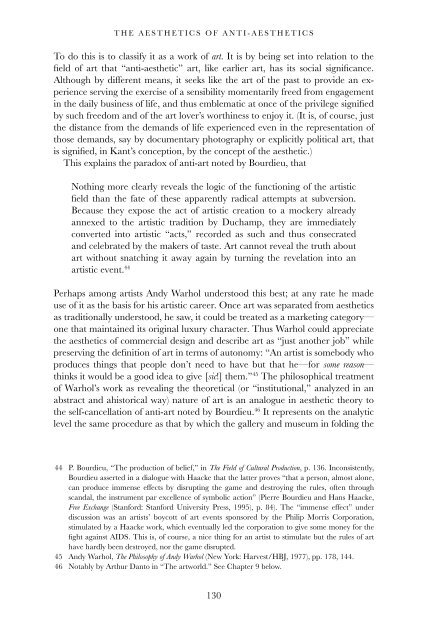Art in its Time: Theories and Practices of Modern Aesthetics
Art in its Time: Theories and Practices of Modern Aesthetics
Art in its Time: Theories and Practices of Modern Aesthetics
Create successful ePaper yourself
Turn your PDF publications into a flip-book with our unique Google optimized e-Paper software.
THE AESTHETICS OF ANTI-AESTHETICS<br />
To do this is to classify it as a work <strong>of</strong> art. It is by be<strong>in</strong>g set <strong>in</strong>to relation to the<br />
field <strong>of</strong> art that “anti-aesthetic” art, like earlier art, has <strong>its</strong> social significance.<br />
Although by different means, it seeks like the art <strong>of</strong> the past to provide an experience<br />
serv<strong>in</strong>g the exercise <strong>of</strong> a sensibility momentarily freed from engagement<br />
<strong>in</strong> the daily bus<strong>in</strong>ess <strong>of</strong> life, <strong>and</strong> thus emblematic at once <strong>of</strong> the privilege signified<br />
by such freedom <strong>and</strong> <strong>of</strong> the art lover’s worth<strong>in</strong>ess to enjoy it. (It is, <strong>of</strong> course, just<br />
the distance from the dem<strong>and</strong>s <strong>of</strong> life experienced even <strong>in</strong> the representation <strong>of</strong><br />
those dem<strong>and</strong>s, say by documentary photography or explicitly political art, that<br />
is signified, <strong>in</strong> Kant’s conception, by the concept <strong>of</strong> the aesthetic.)<br />
This expla<strong>in</strong>s the paradox <strong>of</strong> anti-art noted by Bourdieu, that<br />
Noth<strong>in</strong>g more clearly reveals the logic <strong>of</strong> the function<strong>in</strong>g <strong>of</strong> the artistic<br />
field than the fate <strong>of</strong> these apparently radical attempts at subversion.<br />
Because they expose the act <strong>of</strong> artistic creation to a mockery already<br />
annexed to the artistic tradition by Duchamp, they are immediately<br />
converted <strong>in</strong>to artistic “acts,” recorded as such <strong>and</strong> thus consecrated<br />
<strong>and</strong> celebrated by the makers <strong>of</strong> taste. <strong>Art</strong> cannot reveal the truth about<br />
art without snatch<strong>in</strong>g it away aga<strong>in</strong> by turn<strong>in</strong>g the revelation <strong>in</strong>to an<br />
artistic event. 44<br />
Perhaps among artists Andy Warhol understood this best; at any rate he made<br />
use <strong>of</strong> it as the basis for his artistic career. Once art was separated from aesthetics<br />
as traditionally understood, he saw, it could be treated as a market<strong>in</strong>g category—<br />
one that ma<strong>in</strong>ta<strong>in</strong>ed <strong>its</strong> orig<strong>in</strong>al luxury character. Thus Warhol could appreciate<br />
the aesthetics <strong>of</strong> commercial design <strong>and</strong> describe art as “just another job” while<br />
preserv<strong>in</strong>g the def<strong>in</strong>ition <strong>of</strong> art <strong>in</strong> terms <strong>of</strong> autonomy: “An artist is somebody who<br />
produces th<strong>in</strong>gs that people don’t need to have but that he—for some reason—<br />
th<strong>in</strong>ks it would be a good idea to give [sic!] them.” 45 The philosophical treatment<br />
<strong>of</strong> Warhol’s work as reveal<strong>in</strong>g the theoretical (or “<strong>in</strong>stitutional,” analyzed <strong>in</strong> an<br />
abstract <strong>and</strong> ahistorical way) nature <strong>of</strong> art is an analogue <strong>in</strong> aesthetic theory to<br />
the self-cancellation <strong>of</strong> anti-art noted by Bourdieu. 46 It represents on the analytic<br />
level the same procedure as that by which the gallery <strong>and</strong> museum <strong>in</strong> fold<strong>in</strong>g the<br />
44 P. Bourdieu, “The production <strong>of</strong> belief,” <strong>in</strong> The Field <strong>of</strong> Cultural Production, p. 136. Inconsistently,<br />
Bourdieu asserted <strong>in</strong> a dialogue with Haacke that the latter proves “that a person, almost alone,<br />
can produce immense effects by disrupt<strong>in</strong>g the game <strong>and</strong> destroy<strong>in</strong>g the rules, <strong>of</strong>ten through<br />
sc<strong>and</strong>al, the <strong>in</strong>strument par excellence <strong>of</strong> symbolic action” (Pierre Bourdieu <strong>and</strong> Hans Haacke,<br />
Free Exchange (Stanford: Stanford University Press, 1995), p. 84). The “immense effect” under<br />
discussion was an artists’ boycott <strong>of</strong> art events sponsored by the Philip Morris Corporation,<br />
stimulated by a Haacke work, which eventually led the corporation to give some money for the<br />
fight aga<strong>in</strong>st AIDS. This is, <strong>of</strong> course, a nice th<strong>in</strong>g for an artist to stimulate but the rules <strong>of</strong> art<br />
have hardly been destroyed, nor the game disrupted.<br />
45 Andy Warhol, The Philosophy <strong>of</strong> Andy Warhol (New York: Harvest/HBJ, 1977), pp. 178, 144.<br />
46 Notably by <strong>Art</strong>hur Danto <strong>in</strong> “The artworld.” See Chapter 9 below.<br />
130
















